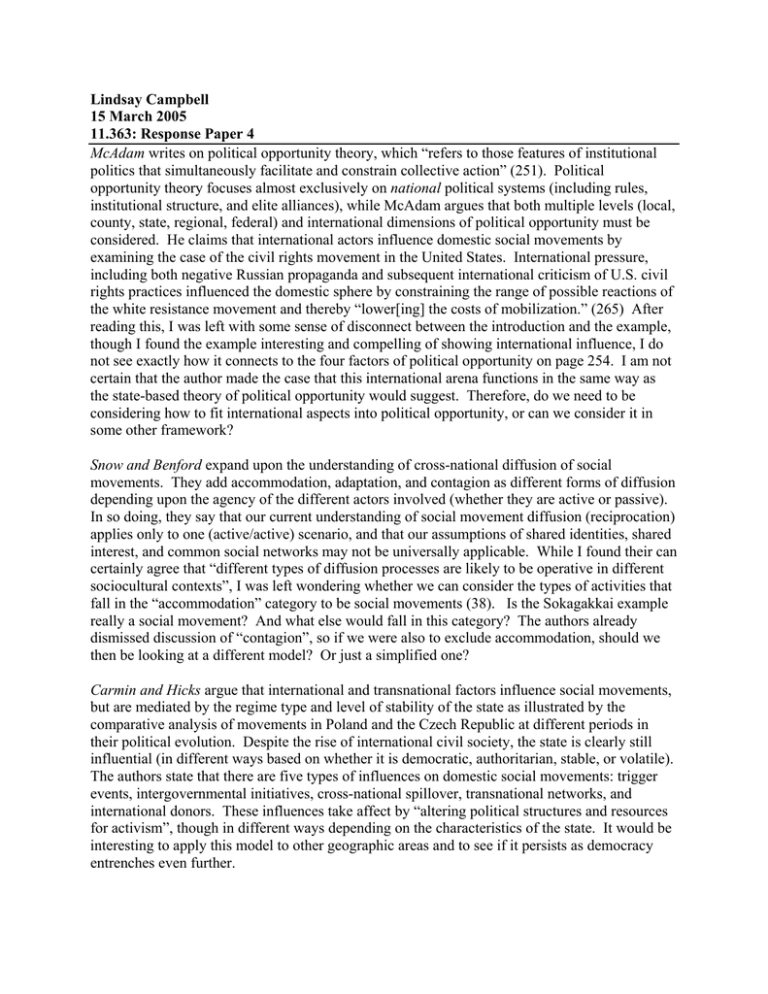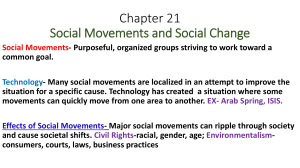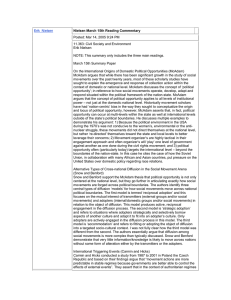Lindsay Campbell 15 March 2005 11.363: Response Paper 4 McAdam
advertisement

Lindsay Campbell 15 March 2005 11.363: Response Paper 4 McAdam writes on political opportunity theory, which “refers to those features of institutional politics that simultaneously facilitate and constrain collective action” (251). Political opportunity theory focuses almost exclusively on national political systems (including rules, institutional structure, and elite alliances), while McAdam argues that both multiple levels (local, county, state, regional, federal) and international dimensions of political opportunity must be considered. He claims that international actors influence domestic social movements by examining the case of the civil rights movement in the United States. International pressure, including both negative Russian propaganda and subsequent international criticism of U.S. civil rights practices influenced the domestic sphere by constraining the range of possible reactions of the white resistance movement and thereby “lower[ing] the costs of mobilization.” (265) After reading this, I was left with some sense of disconnect between the introduction and the example, though I found the example interesting and compelling of showing international influence, I do not see exactly how it connects to the four factors of political opportunity on page 254. I am not certain that the author made the case that this international arena functions in the same way as the state-based theory of political opportunity would suggest. Therefore, do we need to be considering how to fit international aspects into political opportunity, or can we consider it in some other framework? Snow and Benford expand upon the understanding of cross-national diffusion of social movements. They add accommodation, adaptation, and contagion as different forms of diffusion depending upon the agency of the different actors involved (whether they are active or passive). In so doing, they say that our current understanding of social movement diffusion (reciprocation) applies only to one (active/active) scenario, and that our assumptions of shared identities, shared interest, and common social networks may not be universally applicable. While I found their can certainly agree that “different types of diffusion processes are likely to be operative in different sociocultural contexts”, I was left wondering whether we can consider the types of activities that fall in the “accommodation” category to be social movements (38). Is the Sokagakkai example really a social movement? And what else would fall in this category? The authors already dismissed discussion of “contagion”, so if we were also to exclude accommodation, should we then be looking at a different model? Or just a simplified one? Carmin and Hicks argue that international and transnational factors influence social movements, but are mediated by the regime type and level of stability of the state as illustrated by the comparative analysis of movements in Poland and the Czech Republic at different periods in their political evolution. Despite the rise of international civil society, the state is clearly still influential (in different ways based on whether it is democratic, authoritarian, stable, or volatile). The authors state that there are five types of influences on domestic social movements: trigger events, intergovernmental initiatives, cross-national spillover, transnational networks, and international donors. These influences take affect by “altering political structures and resources for activism”, though in different ways depending on the characteristics of the state. It would be interesting to apply this model to other geographic areas and to see if it persists as democracy entrenches even further. Hicks writes about the influence of the EU on domestic Eastern European environmental movements. She argues that the EU is generally supportive of an increased attention to the environment, but with this attention comes a focus on professional NGOs, formalization, westernization, and institutionalization of the movement. This “places a premium on expertise and specialization” (225). EU support also focuses on certain issues and can diminish the visibility and success of non-EU priority movements. In fact, many in the public perceive the instituting of EU policies as “inevitable.” While attempting to support environmental movements and democratic principles, the policymaking mechanisms of the EU itself are not very participatory, she criticizes. Overall, EU influence is pushing the movement more towards a model of policymaking and lobbying rather than direct action and campaign-oriented activities. Crotty investigates the causes of the “stalling of civil society development within the Russian Federation” by examining the relationship between the environmental movement and donors as well as public perceptions of that movement in the Samara oblast (489). She finds that low participation is a result of the perception that voluntary involvement is fanatical and unmodern, as Russia transitions out of an authoritarian regime that had both forced “volunteer” involvement. Generally, she found a low awareness of the work of environmental NGOs by citizens. In terms of donor-organization relationships, she found that donors were not achieving their goals of increasing public awareness of and involvement in the environmental movement. She attributes this largely to the competitive grant process, which requires high administrative costs, and the lack of “contextualization” to donor funding.





